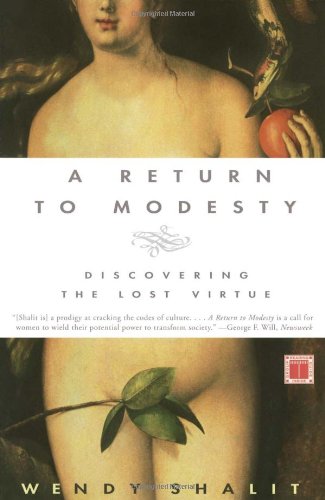What ideas or images come to your mind when you hear the word modesty? Until fairly recently, if I was designing an SAT question, I would probably have put modesty as a word similar to boring, ugly, or weak. Now I’ve learned to see modesty as daring, strong and attractive.
In a recent email exchange with a colleague who is a Muslim theologian, Mohsen Kadivar of Duke University, he asked me to find out for him what the Catholic Church teaches about how women should dress in public. I searched around but found very little official doctrine on this question, so I asked a few Catholic theologians I know and a few Catholic writers on Patheos.
Joanne K. McPortland pointed me to the Catechism of the Catholic Church, which has quite a lengthy section on modesty under the section referring to The Ninth Commandment: “You shall not covet your neighbor’s wife” (Exodus 20:17) and “Everyone who looks at a woman lustfully has already committed adultery with her in his heart” (Matthew 5:28). The Catechism then goes on to say:
“2522 Modesty protects the mystery of persons and their love. It encourages patience and moderation in loving relationships; it requires that the conditions for the definitive giving and commitment of man and woman to one another be fulfilled. Modesty is decency. It inspires one’s choice of clothing. It keeps silence or reserve where there is evident risk of unhealthy curiosity. It is discreet.
2523 There is a modesty of the feelings as well as of the body. It protests, for example, against the voyeuristic explorations of the human body in certain advertisements, or against the solicitations of certain media that go too far in the exhibition of intimate things. Modesty inspires a way of life which makes it possible to resist the allurements of fashion and the pressures of prevailing ideologies.
2524 The forms taken by modesty vary from one culture to another. Everywhere, however, modesty exists as an intuition of the spiritual dignity proper to man. It is born with the awakening consciousness of being a subject. Teaching modesty to children and adolescents means awakening in them respect for the human person.”
There is much wisdom in these statements that people could agree with across different faiths, or even if you have not particular faith. First, modesty is decency and discretion; modesty does not seek to spark the imagination. Modesty protects the mysterious part of ourselves; a necessary step for being able to make a gift of ourselves in marriage. Second, modesty is a way of life that entails avoiding media or fashionable ways of dressing that purposefully make public what should be private. Third, modesty is about dignity: we are subjects and persons, not objects to be displayed or used by others. For people of the Christian, Jewish or Muslim faith, dressing modestly takes on an added significance: how we dress shows our consciousness of being a subject created by God and ultimately responsible to him for what we do with our bodies.
So why did I think modesty was about being boring or weak? Maybe because I feared that the practice of modesty would mean I would have to give up the bold, energetic and very social parts of my personality. To the contrary, I have learned that dressing modestly empowers me to earn respect, be treated with dignity, and develop meaningful friendships with women and men of all ages.
Learning to dress modestly, and in a way that fits my personality and profession, was not an easy task. In graduate school a limited budget and lots of travel meant that I dressed in lots of black, white and gray, and everything was comfortable and versatile from head to toe. It was certainly modest, and also quite plain and boring. Once I realized that I didn’t have to try to make myself ugly or unattractive to be modest, I still wondered how to find suitable fashions in the bewildering amount of choices we have about how to dress.
 Fortunately, a friend from church gave me a book that changed forever how I dress, and really changed how I see myself and what it means to be modest. That book is called It’s So You! by Mary Sheehan Warren, who runs a website by the same name: It’s So You Fashion. To make a long story short, Warren’s book gives uplifting and helpful advice about how to know what colors and styles of clothes make you look your best by dressing so that people’s attention automatically goes to your eyes–the window of the soul–rather than another body part. Our way of dressing should make people want to know the whole person, by which I mean the person as a subject not an object, which of course requires keeping certain things properly covered. Within that general rule, we have quite a lot of latitude to use colors, styles, shapes to look attractive, even beautiful.
Fortunately, a friend from church gave me a book that changed forever how I dress, and really changed how I see myself and what it means to be modest. That book is called It’s So You! by Mary Sheehan Warren, who runs a website by the same name: It’s So You Fashion. To make a long story short, Warren’s book gives uplifting and helpful advice about how to know what colors and styles of clothes make you look your best by dressing so that people’s attention automatically goes to your eyes–the window of the soul–rather than another body part. Our way of dressing should make people want to know the whole person, by which I mean the person as a subject not an object, which of course requires keeping certain things properly covered. Within that general rule, we have quite a lot of latitude to use colors, styles, shapes to look attractive, even beautiful.
Although I’ve never met her, since she runs a business helping women to dress modestly but also beautifully, I emailed Mary and asked her Dr. Kadivar’s question about Catholic teachings on how women should dress in public. She responded:
“Other than sumptuary laws hundreds of years ago, it is a very rare thing for the Church to make statements on specific garments outside of religious habits, etc. Generally, [the church] encourages a spirit of Christian virtue in dress, with a call to modesty and also humility. There are other Christian virtues such as charity that we often forget (i.e. don’t look bad because other people have to look at you.)
On a practical level, practicing modesty is really about context. Think of the most modest swim suit you can find on a beach…maybe a surfing suit. We say it’s modest…but at the beach. Imagine how immodest it would be at Mass! Of course, we can also talk about the fact that what is modest in Tahiti is immodest in Wisconsin. Very. So really, showing a body part is not intrinsically evil. It’s when the context would cause a man (or a woman ) to find titillating.
I was just in Montreal yesterday giving a seminar on Beauty (Bringing your inner beauty to the outside) so your timing is great! For starters, see Wendy Shalit’s “A Return to Modesty.” She’s spot on with this topic. Also, read Alice Von Hildabrand on the “hidden” in woman, and JPII’s section on nudity in art is helpful too.
The bottom line is that in Christian teaching:
1. The body is not bad; There is no “bad” part of the body to be covered because it is intrinsically so.
2. A woman’s body may belong to her husband, but not in the same way as property, so she is not called to cover certain parts (hair, face, etc.) for the sake of respecting him.
3. Sexual arousal is only appropriate between a man and woman in marriage. Therefore, a woman’s clothing should avoid “arousing” fashions. This can be figured out with the guideline of context (cultural, situational, etc.) Now, here is the kicker: There is a fringe number of men (and women) who are aroused (or inspired to imagine) by certain parts of a woman’s body that aren’t necessarily concerned with sex. Much of this is increased by suggestion. Many say an ankle is sexy. Hec, the nape of the neck is considered to be arousing by more than fringe numbers, and we put our hair up all the time.
So, the flip side is that women are called to guard their bodies in dressing and men are called to guard their eyes and imaginations. This is the long way of saying we should all be ladies and gentlemen.”
 I perused Wendy Shalit’s interesting book “A Return to Modesty: Discovering the Lost Virtue” and her blog entitled “Good Girl Revolution: Young Rebels with Self-Esteem and High Standards.” Now that’s a slogan that fits me and many other women I know very well! As Shalit points out in her book and blog, modesty isn’t weakness; it’s strength. Modesty requires some foresight in thinking about how we should dress, some courage to go against pressure to expose our bodies more, but in being modest we also empower ourselves to be bold, daring female leaders who have the respect of men because they see our whole person. I’m pretty confident that I have the respect of my male colleagues and students, and knowing how to dress femininely yet modestly has been a key to my self-confidence.
I perused Wendy Shalit’s interesting book “A Return to Modesty: Discovering the Lost Virtue” and her blog entitled “Good Girl Revolution: Young Rebels with Self-Esteem and High Standards.” Now that’s a slogan that fits me and many other women I know very well! As Shalit points out in her book and blog, modesty isn’t weakness; it’s strength. Modesty requires some foresight in thinking about how we should dress, some courage to go against pressure to expose our bodies more, but in being modest we also empower ourselves to be bold, daring female leaders who have the respect of men because they see our whole person. I’m pretty confident that I have the respect of my male colleagues and students, and knowing how to dress femininely yet modestly has been a key to my self-confidence.
Lest you think modesty is only something women must be concerned with, Warren and Shalit also both argue that men have a big responsibility as well. Men need to have the virtue of self-control of their imaginations, words and bodies in order to treat women with respect and dignity. At some point, as Warren pointed out, anything a woman wears could be considered suggestive, so men also have to struggle for purity in thought and action. But it’s a battle worth fighting, as modesty and purity, like all the virtues, ultimately empowers us to be our full selves.












